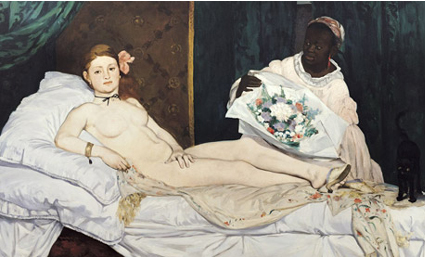A somewhat tubby American tourist sidles up to one of the more famous paintings in the Musee d'Orsay and beams at his wife who faces him, camera at the ready. ''Okay honey, I'm ready.'' She depresses the shutter button, the flash flashes (''No flash'' it says on the walls of the museum), and they're gone.
The painted lady who has provided the backdrop for this exercise in souvenir-snatching remains un-moved. She has seen stranger things in her time. Nevertheless, there is something slightly unreal about the scene that has just been played out. It is tempting to wonder whether that busy, overweight gentleman real-ises the nature of the company he has been keeping. The French have a lot of words for what she is: une impure; une amazone; une fille de marbre; une mangeuse d'homme; une horizontale. Edouard Manet, who painted her, simply called her Olympia.
Olympia continues to regard those who come within her orbit with that unsettling gaze - a mixture of im-pertinence, business acumen and, perhaps, sadness - which made so many of the people who witnessed her first public appearance feel so profoundly uncomfortable. She was painted in 1863 but, for reasons that remain mysterious, her creator did not see fit to place her on view until the summer of 1865. Olympia was exhibited at the annual Paris salon in that year, and within days Manet's painting had received the most hos-tile reviews in the annals of French art criticism.
''An epidemic of crazy laughter prevails before the canvas by Manet,'' reported Le Moniteur des Arts. ''Olympia is a nude, recumbent woman to whom some sort of Negress offers a bouquet voluminously wrapped in paper. At the foot of the bed crouches a black cat, its hair on end, which probably doesn't like flowers since it cuts...


